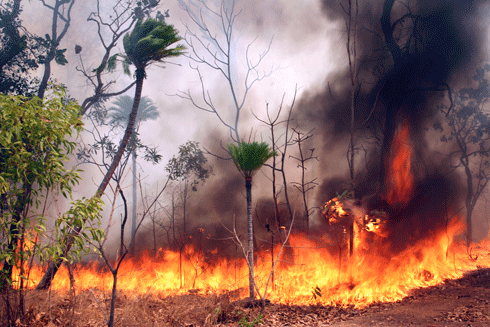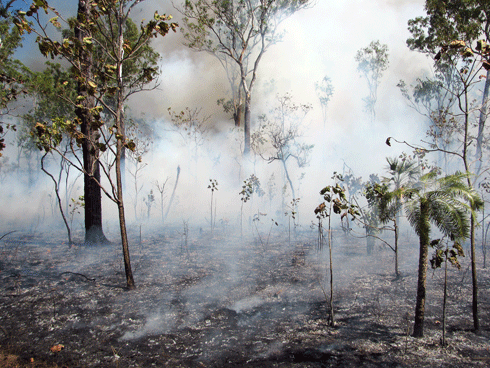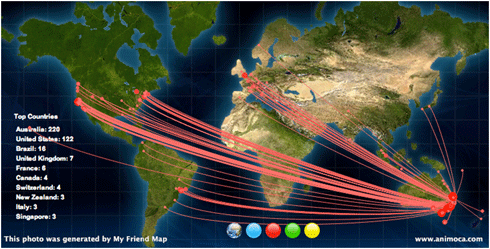
|
Published: 8 July 2013
Fire, carbon and Indigenous livelihoods in the Top End
For hundreds of thousands of years, dry-season burning has shaped the ecology of the Northern Territory’s Top End. Now, through its role in carbon abatement, controlled burning is playing an important role in the region’s economy, especially in remote Aboriginal communities.

|
|
Improved fire management across northern Australia could reduce greenhouse gas emissions by more than 2.25 million tonnes of carbon dioxide equivalent each year. Credit:
CSIRO
|
The Top End’s tropical savanna landscapes are among the most fire-prone ecosystems on Earth. Methane and nitrous oxide emissions from savanna burning represent a significant proportion – 3 per cent on average – of Australia’s total greenhouse gas emissions.
With the federal government currently pricing carbon at about $25 a tonne, that represents a lot of money going up in smoke.
Most emissions from savanna burning are generated by higher-intensity wildfires that sweep through remote areas during the late dry season, in September and October.
Such fires would have been far more limited in pre-colonial times because of traditional Aboriginal burning earlier in the dry season. Following European colonisation, most Aboriginal people moved off their clan estates to larger settlements. As a result, fire is now largely unmanaged in vast areas of northern Australia.
As well as producing greenhouse gases, wildfires also threaten iconic biodiversity values. These include the sandstone country of World Heritage-listed Kakadu National Park, home to many plant and animal species found nowhere else in the world.
Thus the new carbon economy provides a strong incentive for improving fire management both to reduce greenhouse gas emissions and protect biodiversity.
Many remote Aboriginal communities have retained their traditional fire knowledge, and have strong aspirations for fulfilling cultural obligations through re-establishing traditional management on their homelands. Consequently, a highly skilled and motivated workforce for improved fire management is already ‘on site’.
The pricing of carbon has created the perfect storm for job opportunities in Australia’s most disadvantaged sector, which has few other opportunities for engaging in the mainstream economy.
These job opportunities were first realised by the Western Arnhem Land Fire Abatement (WALFA) project.
WALFA commenced in 2004, with $17 million funding from energy company Conoco-Phillips. Aboriginal traditional owners and ranger groups have been employed to undertake prescribed burning early in the dry season, which limits the extent of unmanaged wildfires later in the season. This reduces overall greenhouse gas emissions and protects the biodiversity values of adjacent Kakadu National Park.
Similar projects are being rolled out right across northern Australia under the guidance of the North Australian Indigenous Land and Sea Management Alliance (NAILSMA), as well as by independent Aboriginal organisations, such as the Tiwi Land Council.

|
|
Methane and nitrous oxide emissions from savanna burning represent around 3 per cent of Australia’s total greenhouse gas emissions. Credit:
CSIRO
|
CSIRO modelling indicates that improved fire management across northern Australia has the potential to reduce greenhouse gas emissions by more than 2.25 million tonnes of carbon dioxide equivalent each year.1
This is likely to be a very conservative estimate. Currently, only the methane and nitrous oxide released during savanna burning is included in Australia’s greenhouse gas accounts. Much more carbon dioxide is released than methane or nitrous oxide, but the national accounts assume that all the carbon dioxide is taken up by plant growth over the following wet season.
However, savanna ecologists know that fire affects carbon stocks both above- and below-ground, and that a reduction in fire severity is likely to lead to enhanced carbon storage in ecosystems. Preliminary studies by CSIRO indicate that increased storage of carbon in the soil alone through reduced burning represents a far greater reduction in greenhouse gas emissions than is currently accounted for with methane and nitrous oxide.
Scientists are working on an improved understanding of the effects of fire on carbon storage, in support of the development of a robust accounting methodology that can accommodate the enormous spatial and temporal variability that is inherent in ecosystems. With such a methodology in place, this would mean more greenhouse gas reductions, and more economic opportunity, through improved savanna burning.
Dr Alan Andersen is a Chief Research Scientist with CSIRO's Ecosystem Sciences and leads the tropical savanna research team at CSIRO in Darwin, Northern Territory. He is also an Adjunct Professor at Charles Darwin University.
1 Carbon dioxide equivalent is a measure used to compare the emissions from various greenhouse gases based upon their global warming potential. For example, the global warming potential for methane over 100 years is 21. This means that emissions of one million metric tons of methane is equivalent to emissions of 21 million metric tons of carbon dioxide. See OECD Glossary of Statistical Terms







